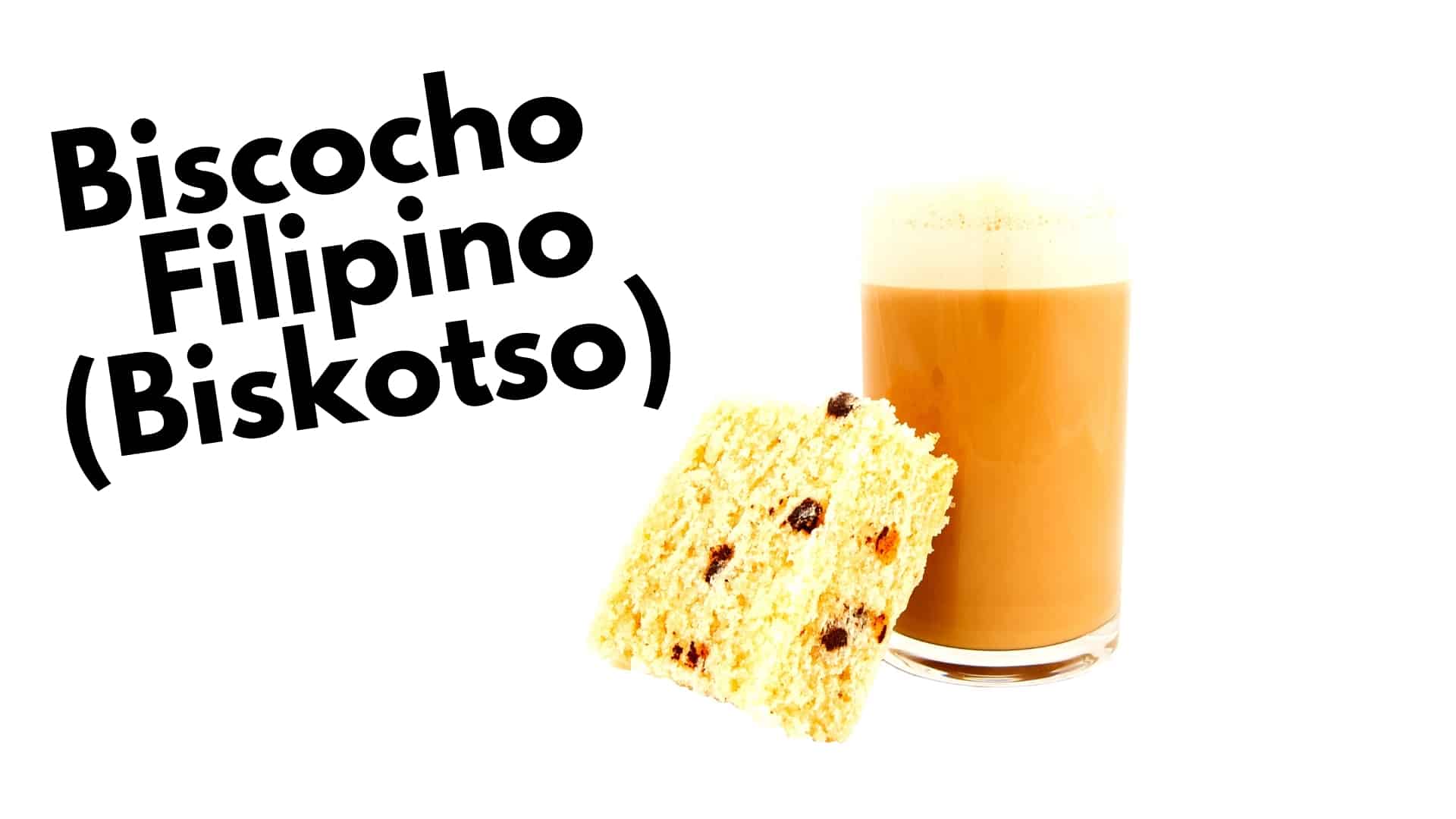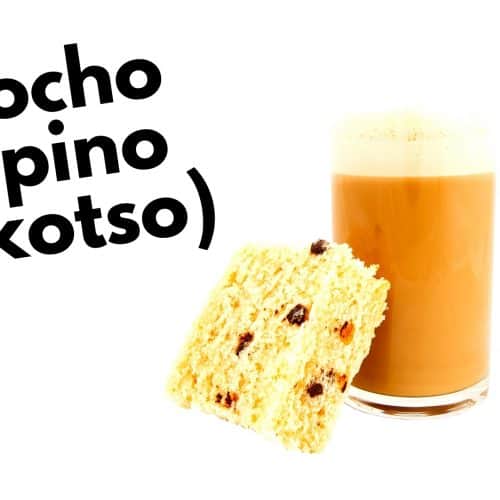Biscocho (Biskotso): A Filipino snack recipe borrowed from Spain
As the name already implies, biscocho is obviously another one of those Spanish-influenced snacks that Filipinos have embraced and absorbed.
The biscocho recipe has its counterparts in the Hispanic and Latin American countries, with varying similarities to my recipe. It’s also similar to Italian biscotti.
Bread is the main ingredient in this crunchy afternoon snack. It’s basically a baked slice of bread with a butter-sugar mixture thinly covering it.
Depending on who’s preparing the biskotso or how much convenience you want, the bread can be baked at home or brought from the supermarket. Or you can always grab leftover bread from yesterday’s merienda!



Check out our new cookbook
Bitemybun's family recipes with complete meal planner and recipe guide.
Try it out for free with Kindle Unlimited:
Read for freeIn this post we'll cover:
Biscocho recipe (Filipino biskotso)
Ingredients
- ½ cup unsalted butter
- ½ cup white sugar
- 12 pcs stale or fresh slice bread (white whole grain)
Instructions
- Put oven rack in the middle of the oven. Preheat at 325 F.
- Put the butter in a microwaveable bowl and melt.
- Spray baking sheet and arrange the sliced bread.
- Brush bread with butter on each side and sprinkle with sugar.
- Bake bread in a preheated oven for 10 to 15 minutes each side until the bread is crispy. I have a different oven so it may or may not be a longer baking time for you. Pay attention to the bread, as it burns quick!
Check out YouTube user Judith Trickey’s video on making biscocho:
Cooking tips
This biscocho recipe is easy to prepare since there’s barely any real cooking that goes on.
You’ll just have to spread the butter or margarine and sugar on the bread (you can adjust the amount of sugar depending on how sweet or unobtrusive you want the sugar to be) and toast it in a toaster.
If you don’t have a toaster though, you can lightly spread a very thin layer of butter on a baking sheet and toast the bread on top of your baking rack.
Preheat the oven before you start baking the bread. The oven must be nice and hot to ensure the bread gets really crunchy.
For the perfect consistency, cut each roll so it’s 1/2 inch thick. This will ensure you don’t have an exaggerated cooking time, and that the biscocho will be perfectly crunchy.
Some people double-bake the bread to make it extra crunchy. But once is enough if you use high heat.
If you want your crust to be crunchier, don’t use melted butter and opt for softened butter instead.
It’s up to you whether you want to trim your bread’s edges or not.
Substitutions and variations
When it comes to bread types, you can use day-old bread or even fresh if you don’t have stale bread.
You can use all types of bread, from the common pan de sal or ensaymada to more specialized ones like monay, pandesal de mani, and so on. Baliwag is ideal for this recipe because it has a richer flavor.
You can also experiment with different types of sugar, from the common white sugar to brown sugar, muscovado sugar, and cinnamon sugar.
If you like sweet foods, then combine butter with some vanilla extract in a small bowl and then rub it over the bread. Then, top with some lemon zest. This will add more flavor to your snack!
You can also use chocolate chips, chopped nuts, or even grated cheese on top of the biscocho.
Some people want the biscocho to be more like a sponge cake on the interior and crunchy on the exterior, so they coat the bread in a flour mixture with condensed milk.
Alternatively, those who like savory flavors can combine garlic and butter and stir in a bit of salt too.
At the end of the day, there’s no real limit to what else you can add to your coated bread. Be creative and have fun with it!
How to serve and eat
This biscocho recipe is sure to be a go-to recipe for your merienda or breakfast meals.
As breakfast fare, this can be eaten with other foods or on its own. For merienda in both midday and mid-afternoon, this is always served as a standalone dish.
Biscocho is very popular during the holiday season too, where it’s served as a dessert or snack. It’s also an excellent way to use up day-old bread after parties and gatherings.
Best served with hot coffee or chocolate, this is sure to tickle your taste buds in the morning and refresh your stomach during your midday or mid-afternoon merienda!
Similar dishes
There are different types of biscochos. The most common ones are the buttered biscocho, the crinkle-top biscocho, and the Filipino ensaymada.
The buttered biscocho is a popular choice because it’s very easy to make. All you need is some butter, sugar, and stale bread.
The crinkle-top biscocho is made by adding an egg to the dough. This makes the biscochos moister and gives them a crinkly top.
The Filipino ensaymada is a type of sweet brioche that’s often served as breakfast or dessert. It’s made with flour, milk, sugar, eggs, butter, and yeast. The dough is then rolled in grated cheese and baked until golden brown.
Other similar Filipino dishes include puto and pandesal.
Puto is a steamed rice cake that’s often served as a snack or dessert. It’s made with flour, sugar, baking powder, and water.
Pandesal is a type of Filipino bread roll that’s made with flour, salt, yeast, and water. It’s often served as breakfast or merienda.
FAQs
Is biscocho healthy?
Biscocho is not considered to be a healthy snack because of its high sugar and saturated fat content. However, it can be a part of a balanced diet if consumed in moderation.
How do you store biscocho?
Biscocho can be stored in an airtight container at room temperature for up to 2 weeks.
You can also freeze them for up to 6 months.
Can you reheat biscocho?
Yes, you can reheat biscocho in the oven or in the microwave for about a minute or two.
Where did the word “biscocho” originate from?
The word “biscocho” is of Spanish origin and it means “biscuit.”
Can you make biscocho with fresh bread?
Yes, you can make biscocho with fresh bread. However, it’s not recommended because the bread won’t be as dry and crispy.
Make biscocho and have a easy, tasty snack within minutes
This biscocho recipe is a delicious and easy-to-make snack that’s perfect for any time of the day. Made with just a few simple ingredients, this recipe is sure to become a family favorite.
Plus, you can use up any old bread you have at home and reduce food waste. With sweet sugar and butter, this crispy treat is sure to satisfy the munchies.
Try it today and enjoy the unique flavor of this Spanish-inspired Filipino snack!
To learn more about biscocho, read this article.
Check out our new cookbook
Bitemybun's family recipes with complete meal planner and recipe guide.
Try it out for free with Kindle Unlimited:
Read for freeJoost Nusselder, the founder of Bite My Bun is a content marketer, dad and loves trying out new food with Japanese food at the heart of his passion, and together with his team he's been creating in-depth blog articles since 2016 to help loyal readers with recipes and cooking tips.

